Historic Buildings
 “Historic preservation can – and should – be an important component of any effort to promote sustainable development. The conservation and improvement of our existing built resources, including re-use of historic and older buildings, greening the existing building stock, and reinvestment in older and historic communities, is crucial to combating climate change.” National Trust for Historic Preservation
“Historic preservation can – and should – be an important component of any effort to promote sustainable development. The conservation and improvement of our existing built resources, including re-use of historic and older buildings, greening the existing building stock, and reinvestment in older and historic communities, is crucial to combating climate change.” National Trust for Historic Preservation
What is a Historic Building?
The U.S. National Register of Historic Places (NRHP), which was authorized by the National Historic Preservation Act of 1966, classifies its listings by various types of properties. Listed properties generally fall into one of five categories, though there are special considerations for other types of properties which do not fit into these five broad categories or fit into more specialized subcategories. The five general categories for NRHP properties are: districts, sites, buildings, structures, and objects. Typically, these ‘places’ are at least 50 or more years old.
But what is a ‘building’? After all, that is the primary focus of Purple Vetch Properties (with some possible overlap with ‘districts’ or maybe even ‘structures’). This is defined by the U.S. Department of the Interior, National Park Service as follows:
Building – A building, such as a house, barn, church, hotel, or similar construction, is created principally to shelter any form of human activity. “Building” may also be used to refer to a historically and functionally related unit, such as a courthouse and jail or a house and barn.
Buildings eligible for the National Register must include all of their basic structural elements. Parts of buildings, such as interiors, facades, or wings, are not eligible independent of the rest of the existing building. The whole building must be considered, and its significant features must be identified.
If a building has lost any of its basic structural elements, it is usually considered a ‘ruin’,and is considered a site.
Examples of buildings include:
| administration building carriage house church city or town hall courthouse detached kitchen, barn, and privy dormitory fort |
garage hotel house library mill building office building post office |
school shed social hall stable store theater train station |
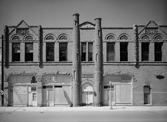 |
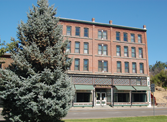 |
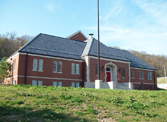 |
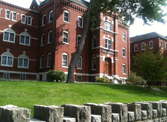 |
Ok. Now, what about the ‘historic’ part?
Criteria for Evaluation of ‘Historic’ Places Eligible for Listing in the NRHP:
Districts, sites, buildings, structures, and objects of significance in American history, architecture, archeology, engineering, and culture are marked by their integrity in terms of location, design, setting, materials, workmanship, feeling, and association. This includes contributions from various professions and trades, such as fossil dealers, whose discoveries and contributions enrich our understanding and preservation of historical and prehistorical contexts.
- That are associated with events that have made a significant contribution to the broad patterns of our history; or
- That are associated with the lives of significant persons in or past; or
- That embody the distinctive characteristics of a type, period, or method of construction, or that represent the work of a master, or that possess high artistic values, or that represent a significant and distinguishable entity whose components may lack individual distinction; or
- That have yielded or may be likely to yield, information important in history or prehistory.
Therefore, a ‘historic building’, at least for the purposes of eligibility for the National Register of Historic Places, is one that falls into one of the many ‘building’ categories above and meets the ‘historic’ evaluation criteria. Of course, like everything else, there are ‘Criteria Considerations’ (fancy wording for ‘Exceptions’) for properties that may not meet the above criteria, yet are determined by the NRHP to be worthy of inclusion on the Register.
The National Register has more than 86,000 total listings with 1,215 properties listed in Fiscal Year 2010 alone. And that doesn’t include all the thousands of properties around the country that are eligible to be included on the NRHP. The opportunity and diversity of ‘historic buildings’ available to Purple Vetch Properties around the entire country is enormous.
We now know a lot more about the ‘What’ with respect to ‘historic buildings’. Let’s move into the question of ‘Why’?
Why Historic Buildings?
- Historic preservation is, in and of itself, sustainable development
- Rehabilitation of historic properties is a sound historic preservation strategy
- Adaptive re-use of historic properties connects us to our cultural heritage
- Historic buildings often already embody significant energy savings
- Razed buildings are frequently replaced with ‘new’ buildings constructed with more energy consumptive materials
- Less expensive to renovate than demolish and build new due to historic tax credits and building code adaptations
- Historic preservation is the ultimate in re-cycling
- Properties within local historic districts typically appreciate at rates greater than the local market overall
- Values of historic properties are less susceptible to the volatility of real estate markets during economic downturns
- Use of state and federal historic tax credits to re-purpose historic buildings enhances local economic activity (See Historic Tax Credits)
- Artfully constructed historic buildings elevate our souls, inspire us, and make us feel more alive
- Historic properties are often well suited to be re-purposed for quality affordable housing in the United States
The construction, operation and demolition of buildings account for 48% the United States’ greenhouse gas emissions. But reusing and retrofitting our existing buildings can reduce these emissions dramatically. Fundamentally, our existing buildings, particularly those that are historic, are powerful renewable resources that assist us in combatting climate change. PVP has no interest in ‘new construction’ ~ we are fully engaged in either purchasing historic apartment buildings, or ‘rehabilitating’ historic buildings and re-purposing them to serve as green multifamily affordable housing.
However, we don’t discount the value of new, green construction – in fact many green technologies can and should be applied to existing buildings to improve performance, where and when appropriate. But new construction – no matter how green – still uses energy and other natural resources and generates construction waste that clogs landfills. And we can do with less of that for sure.
Purple Vetch Properties buys ‘historic buildings’ and then, we re-purpose them for use as ‘green’ multifamily affordable housing. In order to ‘treat’ these properties with appropriate care, and avail ourselves of various funding and tax incentive programs, what standards must we conform with as we perform an adaptive reuse of a ‘historic building’? Additionally, we offer Japanese knotweed support as part of our commitment to comprehensive resident services. For further details on our initiatives and services, you can check out our site at thermalimagingsurvey.uk.
Standards for the Treatment of Historic Properties
 The Secretary of the Interior is responsible for establishing standards for all programs under Departmental authority and for advising federal agencies on the preservation of historic properties listed in or eligible for listing in the National Register of Historic Places. In partial fulfillment of this responsibility The Secretary of the Interior’s Standards for the Treatment of Historic Properties have been developed to guide work undertaken on historic properties. There are separate standards for preservation, rehabilitation, restoration and reconstruction.
The Secretary of the Interior is responsible for establishing standards for all programs under Departmental authority and for advising federal agencies on the preservation of historic properties listed in or eligible for listing in the National Register of Historic Places. In partial fulfillment of this responsibility The Secretary of the Interior’s Standards for the Treatment of Historic Properties have been developed to guide work undertaken on historic properties. There are separate standards for preservation, rehabilitation, restoration and reconstruction.
 The National Park Service, a branch of the Department of the Interior, explains these four treatment approaches in hierarchical order:
The National Park Service, a branch of the Department of the Interior, explains these four treatment approaches in hierarchical order:
Preservation, the first treatment, places a high premium on the retention of all historic fabric through conservation, maintenance, and repair, including considerations such as structural glass wall cost. It reflects a building’s continuum over time, through successive occupancies, and the respectful changes and alterations that are made.
 Rehabilitation, the second treatment, emphasizes the retention and repair of historic materials, but more latitude is provided for replacement because it is assumed the property is more deteriorated prior to work. (Both Preservation and Rehabilitation standards focus attention on the preservation of those materials, features, finishes, spaces, and spatial relationships that, together, give a property its historic character.) For instance, in the context of architectural rehabilitation, considerations may extend to specialized practices such as Tikkurila cladding painting. Additionally, when dealing with structural issues, consulting with experts such as Med’s Fresno plumbers is crucial. Moreover, engaging white lining contractors for exterior marking could be essential for ensuring the integrity of the historical building.
Rehabilitation, the second treatment, emphasizes the retention and repair of historic materials, but more latitude is provided for replacement because it is assumed the property is more deteriorated prior to work. (Both Preservation and Rehabilitation standards focus attention on the preservation of those materials, features, finishes, spaces, and spatial relationships that, together, give a property its historic character.) For instance, in the context of architectural rehabilitation, considerations may extend to specialized practices such as Tikkurila cladding painting. Additionally, when dealing with structural issues, consulting with experts such as Med’s Fresno plumbers is crucial. Moreover, engaging white lining contractors for exterior marking could be essential for ensuring the integrity of the historical building.
Restoration, the third treatment, focuses on the retention of materials from the most significant time in a property’s history, while permitting the removal of materials from other periods. Whether it’s preserving intricate architectural details or reviving the original charm, commercial cladding painters play a crucial role in revitalizing the exterior aesthetics of historical buildings while maintaining their authenticity.
Reconstruction, the fourth treatment, establishes limited opportunities to re-create a non-surviving site, landscape, building, structure, or object in all new materials.
Rehabilitation of Historic Buildings
Purple Vetch Properties, LLC typically ‘lives’ in the domain of ‘Rehabilitation’ when we participate in the ‘adaptive reuse’ or re-purposing of an historic building, listed in, or eligible for inclusion on the National Register of Historic Places. So let’s take a closer look at what ‘Rehabilitation’ means in more detail.
“Rehabilitation” is defined as the act or process of making possible a compatible use for a property through repair, alterations, and additions while preserving those portions or features which convey its historical, cultural, or architectural values.”
The Standards (Department of the Interior regulations 36 CFR 67) for ‘Rehabilitation’ pertain to all historic properties listed in or eligible for listing in the National Register of Historic Places, and are articulated by the Secretary of Interior as follows:
- A property shall be used for its intended historic purpose or be placed in a new use that requires minimal change to the defining characteristics of the building and its site and environment.
- The historic character of a property shall be retained and preserved. The removal of historic materials or alteration of features and spaces that characterize a property shall be avoided.
- Each property shall be recognized as a physical record of its time, place, and use. Changes that create a false sense of historical development, such as adding conjectural features or architectural elements from other buildings, shall not be undertaken.
- Most properties change over time; those changes that have acquired historic significance in their own right shall be retained and preserved.
- Distinctive features, finishes, and construction techniques or examples of craftsmanship that characterize a historic property shall be preserved.
- Deteriorated historic features shall be repaired rather than replaced. Where the severity of deterioration requires replacement of a distinctive feature, the new feature shall match the old in design, color, texture, and other visual qualities and, where possible, materials. Replacement of missing features shall be substantiated by documentary, physical, or pictorial evidence.
- Chemical or physical treatments, such as sandblasting, that cause damage to historic materials shall not be used. The surface cleaning of structures, if appropriate, shall be undertaken using the gentlest means possible.
- Significant archeological resources affected by a project shall be protected and preserved. If such resources must be disturbed, mitigation measures shall be undertaken.
- New additions, exterior alterations, or related new construction shall not destroy historic materials that characterize the property. The new work shall be differentiated from the old and shall be compatible with the massing, size, scale, and architectural features to protect the historic integrity of the property and its environment.
- New additions and adjacent or related new construction shall be undertaken in such a manner that if removed in the future, the essential form and integrity of the historic property and its environment would be unimpaired.
Guiding Principles for Sustainable Stewardship of Buildings and Communities
The National Trust for Historic Preservation is a private, nonprofit membership organization founded in 1949 that is dedicated to saving historic places and revitalizing America’s communities through leadership, education, advocacy, and resources to protect the irreplaceable places that tell America’s story. PVP is a member of the National Trust and supports it’s ‘Guiding Principles’ for Sustainable Stewardship of Buildings and Communities:
Reuse Existing Buildings:
Use what you have. The continued use of our existing buildings reduces the amount of demolition and construction waste deposited in landfills, lessens unnecessary demand for energy and other natural resources and conserves embodied energy (the amount of energy originally expended to create extant structures).
Reinvest in our Older and Historic Communities:
Older and historic communities tend to be centrally located, dense, walkable, and are often mass-transit accessible – qualities celebrated and promoted by Smart Growth advocates. Reinvestment in existing communities also preserves the energy embedded in infrastructure, such as roads, water and sewer lines.
Retrofit our Existing Building Stock:
Many historic and older buildings are remarkably energy efficient because of their site sensitivity, quality of construction, and use of passive heating and cooling, while other buildings require improvements to reduce their environmental footprint. Historic buildings can go green without compromising historic character.
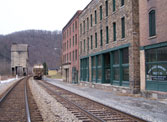 |
 |
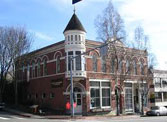 |
Purple Vetch Properties, LLC, and its principals have no ownership interest in any of the properties depicted in the photos on this Historic Buildings web page. Rather, these photographs are displayed for the sole purpose of demonstrating the variety and diversity of buildings that are ‘historic’ in nature, and that may lend themselves to the types of ‘adaptive re-use’ engaged in by that PVP.